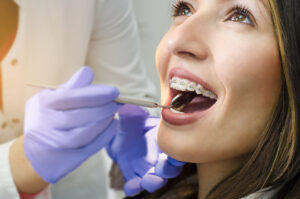Are Wisdom Teeth Making My Other Teeth Crooked?
The idea that wisdom teeth cause the crowding of teeth at the front of the mouth (known as the anterior teeth) is a myth. For this to be the case, it would require a budding new tooth to push more than five other established teeth at once. That would be quite a feat if it were to happen, but it doesn’t. So, what is the basis of this myth, and why do so many people believe it to be true? The answer is quite simple.
Jaw Development
As part of normal human development, the jawbone changes (grows and shifts) throughout life, but especially during late adolescence and early adulthood. When the jaw narrows, it may cause crowding in the anterior (front) teeth. These shifts often coincide with the time when wisdom teeth emerge. Because of the coincidental timing, people falsely assume the two changes are related.
Why Wisdom Teeth are Extracted
Dentists, oral surgeons, and orthodontists recommend wisdom tooth extraction for patients for reasons other than anterior crowding. Impacted wisdom teeth, teeth that don’t fully break through the gum, are incredibly painful and can become infected. With extraction, the pain is gone and the risk for infection reduced to almost nothing. Furthermore, if wisdom teeth come in at the wrong angle, they could potentially damage the teeth next to them. In such cases, the new teeth are extracted to protect the older teeth. Finally, there are times when wisdom teeth are extracted because they are difficult for the patient to keep clean due to their tight location. Over time, this poor cleaning access can lead to tooth decay and pain. Better to extract the teeth before such pain occurs.
In none of these occurrences are the wisdom teeth seen as the cause for crowding in other teeth. Because they do not cause crowding, removing wisdom teeth will not correct crowding either. They are separate issues altogether.
Why Anterior Teeth Become Crowded
As humans grow and develop, the lower anterior jaw sees the most change in the facial region. In most cases, the jaw becomes narrower. This narrowing causes concern for many scientists and biologists, primarily because of tangential, health-related issues. For the purposes of this article, however, only the impacts on anterior teeth are considered.
A narrowing jaw means there is less room for the teeth to share, resulting in a battle for space that leads to crooked teeth. There are also some lifestyle habits that contribute to teeth crowding over time: thumb sucking, mouth breathing, etc.
An Orthodontic Solution
Removing your wisdom teeth may solve some dental problems, but it will not straighten your crooked teeth. For that, you need orthodontics. More specifically, you need professional orthodontists who understand how jaw growth impacts your teeth and jaw alignment so they can provide a treatment plan that addresses both. That plan typically begins with x-rays, 3D cans, or both, so the orthodontist has a clear understanding of what’s happening “behind the scenes” in your mouth.









